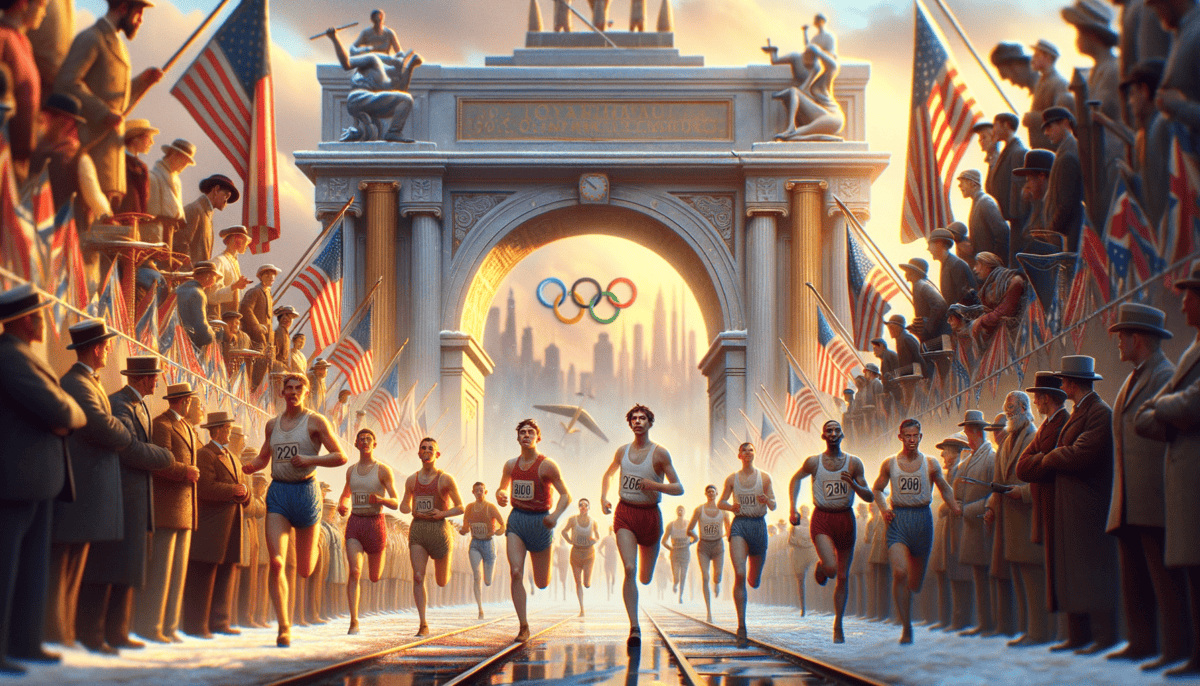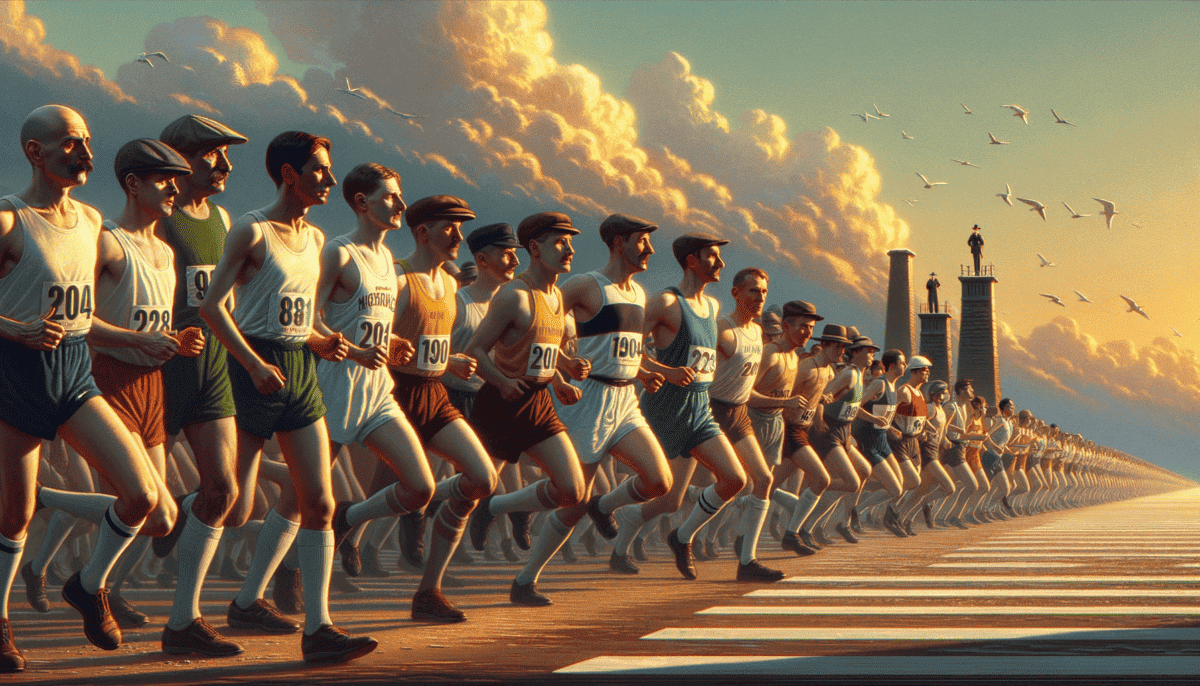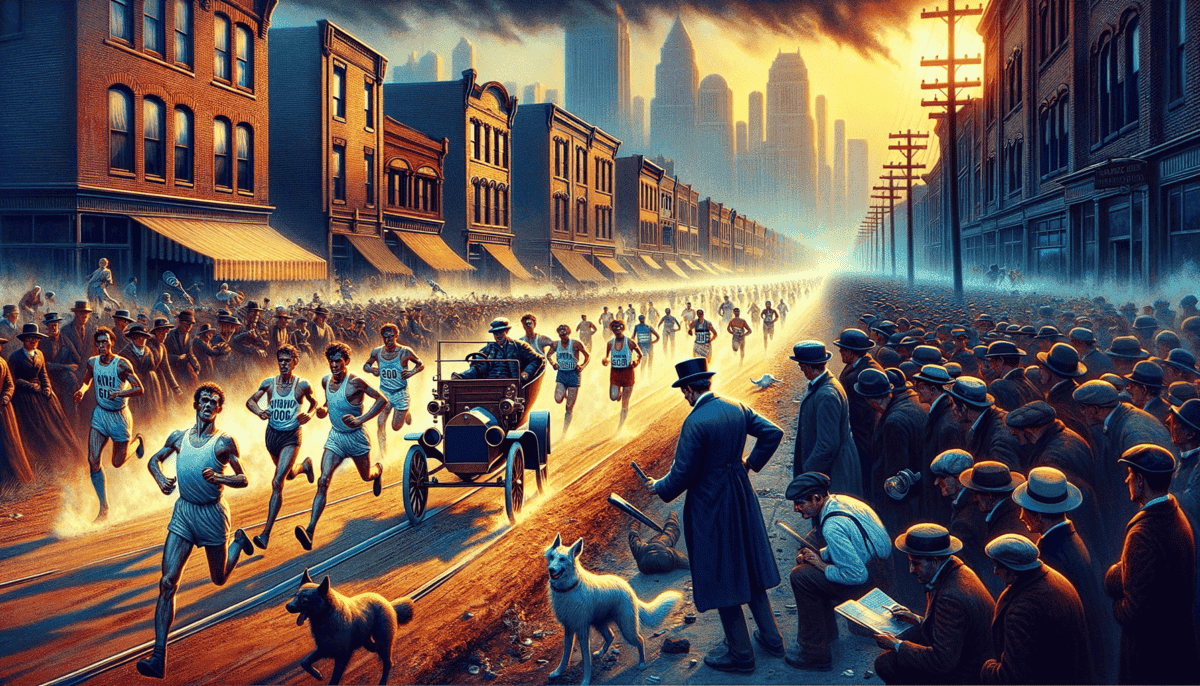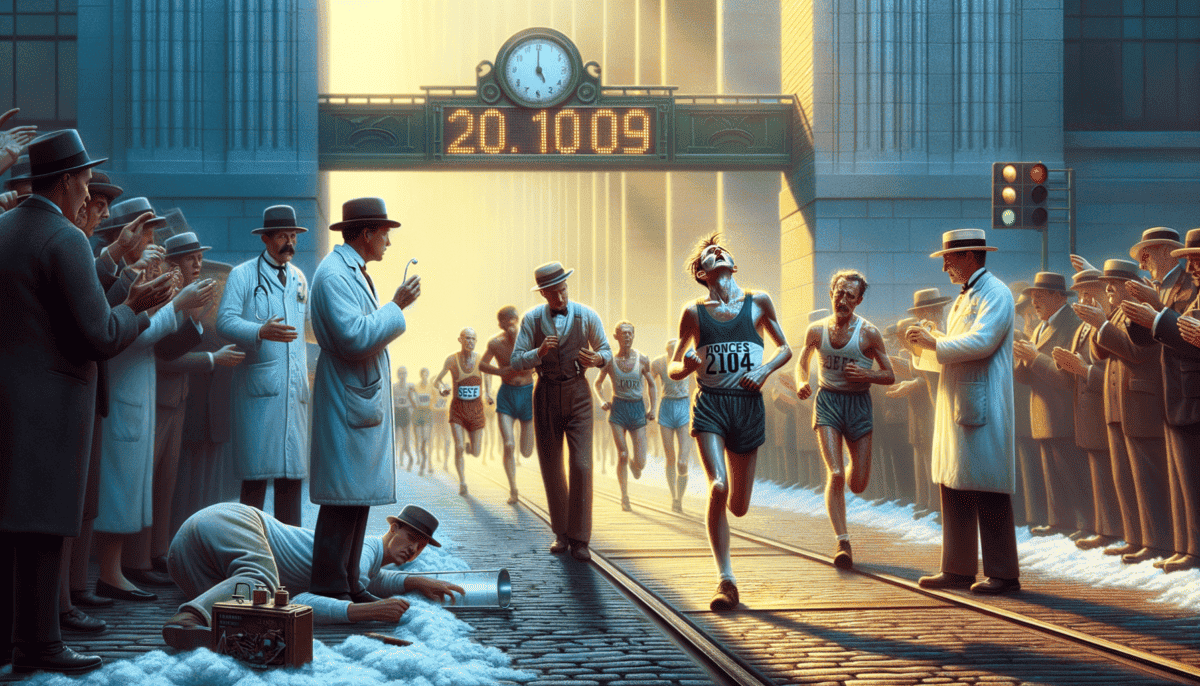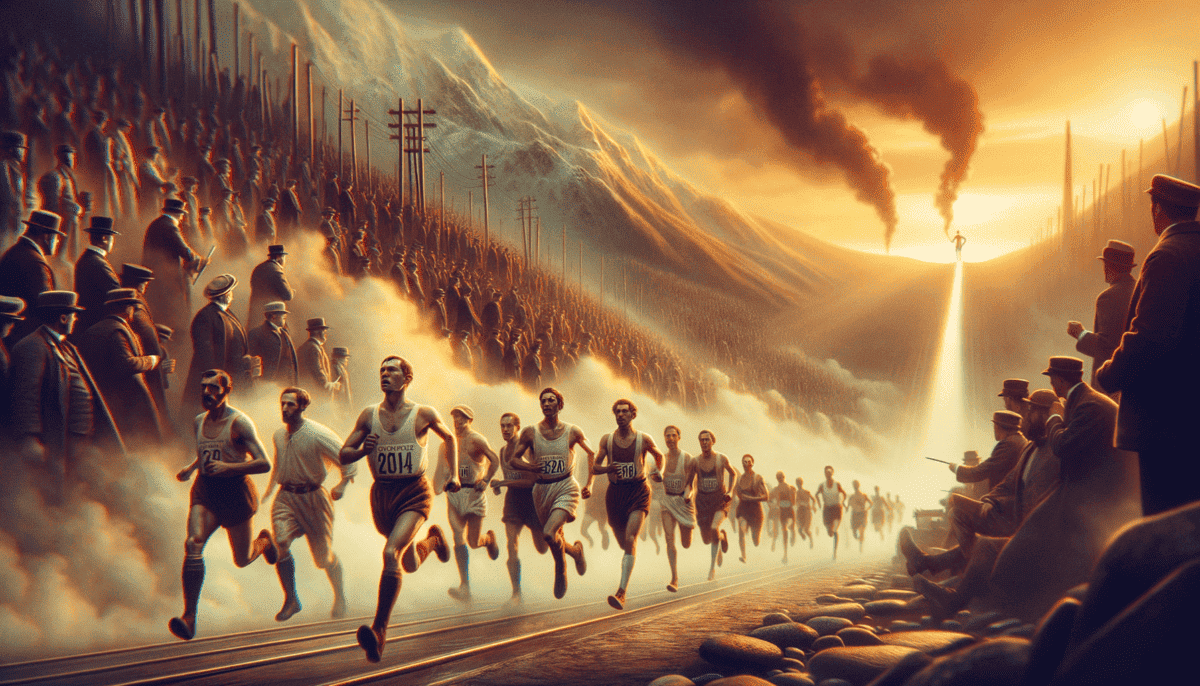A Race Like No Other
The sun beat down on St. Louis like a giant hot lamp. It was August 30, 1904, and the city was buzzing with excitement. The Olympic Games were in town!
But this wasn't going to be just any race. This was going to be the hardest marathon anyone had ever seen.
Fred Lorz tied his shoelaces tight. He was one of the runners getting ready for the big race. Next to him, Thomas Hicks wiped sweat from his face. The race hadn't even started yet, but it was already super hot!
"It must be over 90 degrees!" Fred said to Thomas.
"And look at all that dust in the air," Thomas replied, pointing at the dirt road ahead.
The Brave Runners
There were 32 brave runners at the starting line. Some came from far away places like South Africa. Len Taunyane had never seen such a big city before. He was used to running on grassy plains back home.
"The roads here are so different," Len said, looking worried at the dusty path ahead.
The race course was really tricky. The runners would have to:
• Run up and down big hills
• Deal with super hot weather
• Dodge cars and trucks on dusty roads
• Watch out for wild dogs
• Run for 26 miles!
A Tough Challenge
Dr. Charles Lucas, the race doctor, shook his head. "This is going to be rough," he said. "The heat is dangerous. We need more water stations."
But there were only a few places where runners could get water. Some water wells along the way were bad to drink from.
The runners lined up at the starting line. Their hearts were beating fast. Some looked scared, others excited. They all knew this would be the hardest race of their lives.
"On your marks!" the official shouted.
Fred looked at the sky. Not a cloud in sight. No shade anywhere.
"Get set!"
Thomas took a deep breath. The dust was already making it hard to breathe.
BANG!
The gun went off. The impossible race had begun. The runners charged forward, not knowing that they were about to be part of one of the craziest races in Olympic history.
Little did they know that only half of them would finish the race. Some would get really sick. Others would try to cheat. And one runner would barely make it to the finish line alive!
The 1904 Olympic marathon was more than just a race. It was about to become a wild adventure that people would talk about for many years to come.
Getting Ready for Glory
The runners had very different ways of getting ready for the big race. Back then, nobody really knew the best way to train for a marathon! ♂️
Fred Lorz worked as a bricklayer in Boston. He would run early in the morning before going to work. “Running makes me strong,” he told his friends. “But this heat in St. Louis is something else!”
Different Runners, Different Stories
Thomas Hicks loved to run, but he didn’t know much about staying healthy during a long race. His friends gave him weird advice:
“Don’t drink water during the race – it will make you sick!” one friend said.
“Eat raw eggs before running,” said another.
Poor Thomas didn’t know these were bad ideas!
Runners from Far Away
Len Taunyane and his friend Jan Mashiani came all the way from South Africa. They were the first African athletes in the Olympics! They were used to running long distances while delivering messages back home.
“We run barefoot in our country,” Len explained to the other runners, who stared at his feet in surprise.
Some runners couldn’t even speak to each other because they spoke different languages. But they all shared big smiles and friendly waves.
Training Days
The days before the race were busy. Runners tried to learn about the race course, but it was hard. There were no good maps back then!
Here’s what the runners did to get ready:
• Ran short distances every day
• Tried to get used to the hot weather
• Learned where the few water stops would be
• Made sure their shoes fit well
• Got plenty of rest
Race Day Morning
On race day morning, everyone was nervous. Some runners hadn’t slept well. The air was already hot at 3:00 PM when the race would start.
“My stomach feels funny,” said Cuban runner Felix Carvajal. He had lost all his money gambling and hadn’t eaten much.
William Garcia from California looked worried too. “The dust is worse than yesterday,” he said, coughing.
Dr. Lucas walked around checking on the runners. “Remember to take it slow,” he warned them. “This isn’t a normal race.”
The runners put on their race numbers. Some wore long pants and long-sleeve shirts – that’s what runners wore back then! Can you imagine running in long pants on a hot day?
Last-Minute Preparations
“Five minutes until start time!” shouted the race official.
Runners jumped up and down to warm up. Some said quick prayers. Others took deep breaths.
Thomas Hicks looked at the dusty road ahead. “We’re about to make history,” he said.
He was right – but not in the way anyone expected. The craziest marathon ever was about to begin, and these brave runners had no idea what was waiting for them on that hot, dusty road to the finish line.
The Race Begins!
The big moment arrived! At exactly 3:03 PM, the starting gun went BANG! Thirty-two runners rushed forward into the hot afternoon sun. ♂️
A Dusty Start
Right away, things got tricky. A big cloud of dust filled the air as cars and horses moved along the dirt road ahead of the runners. Many runners started coughing.
“I can’t see!” shouted William Garcia, rubbing his eyes.
Felix Carvajal, the happy Cuban runner, didn’t seem to mind. He stopped to wave at people watching the race and told funny jokes in Spanish. He even ran backward sometimes to make people laugh!
The First Big Hill
After one mile, the runners faced their first big challenge – a steep hill! Fred Lorz took the lead, running strong up the hill. Thomas Hicks stayed close behind him.
“Pace yourself!” shouted Dr. Lucas from a car. “It’s too hot to run fast!”
But many runners didn’t listen. They wanted to win too badly!
Trouble on the Road
The road was full of surprises! The runners had to dodge:
• Cars kicking up dust
• Horse wagons moving slowly
• Dogs that chased the runners
• Trains crossing their path
• Deep mud puddles
Len Taunyane got a big scare when a dog chased him for half a mile! But being a fast messenger runner from South Africa, he knew how to handle wild animals.
Where’s the Water?
The runners got very thirsty. But finding water was hard! There was only one place to get water in the first 12 miles.
“Water! I need water!” many runners shouted.
Some kind people who lived along the road tried to help. They brought out cups of water from their homes. But the race officials said this wasn’t allowed!
Leaders Take Shape
After an hour of running, the race had clear leaders:
Fred Lorz was in front, looking strong. Thomas Hicks was second, but he was getting very tired. Felix Carvajal was third, still telling jokes and having fun!
“This is the hardest thing I’ve ever done,” said Hicks, wiping sweat from his face.
Runners Start Dropping Out
The heat and dust were too much for many runners. Some got sick. Others just couldn’t go on.
William Garcia collapsed and had to be taken to a hospital. His throat was bleeding from breathing in so much dust!
Even some of the strongest runners were walking now. The race was turning into something nobody had expected – a fight just to survive!
As the runners pushed forward, the real drama was just beginning. The worst part of the race was still to come, and nobody knew just how crazy things would get on the road ahead…
Breaking Points and Bad Choices
The hot sun beat down as Fred Lorz stumbled. His legs felt like heavy rocks. After nine miles of running, he couldn’t take another step.
A Tempting Ride
“Need a lift?” called his manager from a shiny car. Fred looked at the dusty road ahead. His whole body hurt.
“Just for a little while,” Fred said, climbing into the car.
Thomas Hicks Gets Help
Meanwhile, Thomas Hicks was having his own troubles. His helpers gave him a strange drink.
“What’s in this?” Thomas asked, taking small sips.
“Just stuff to make you stronger,” they said. But it was actually egg whites mixed with strychnine – a dangerous chemical!
Wild Things on the Road
The runners still racing faced crazy problems:
• Wild dogs jumping out of bushes
• Thick dust making it hard to breathe
• No water for miles and miles
• Cars splashing mud on them
• The hot sun making them dizzy
Felix’s Funny Adventure
Felix Carvajal, the happy Cuban runner, saw some people eating peaches. He was so hungry that he stopped to ask for some!
“Gracias!” he said, munching away. His tummy hurt later, but he kept running and laughing.
Fred’s False Finish
After riding in the car for 11 miles, Fred Lorz started running again. He felt much better after his rest.
When he got to the finish line first, people cheered! The president’s daughter was ready to give him a gold medal.
“Did you run the whole way?” someone asked.
Fred looked at his feet. He knew he had to tell the truth.
“No,” he said quietly. “I took a ride in a car.”
The Real Race Continues
While Fred was being sent away in shame, Thomas Hicks was still out there. He could barely walk straight. His helpers held his arms to keep him going.
“Water,” he kept saying. “Please… water.”
But instead of water, they gave him more egg whites and chemicals. This was very dangerous!
Others Struggle On
By now, many runners had given up. The few still moving looked like zombies walking through the dust.
Len Taunyane was doing better than most. Being from hot South Africa helped him handle the heat. But even he was having a hard time.
As the sun started to set, nobody knew who would make it to the finish line. The craziest marathon ever was about to get even crazier…
Victory Through Suffering
The crowd at the finish line waited in the hot evening air. Everyone wanted to know who would win this crazy race!
Thomas Hicks Fights On
Thomas Hicks could barely stand up. His friends held him as he walked. His face was white as chalk.
“Just… a little… more,” he whispered. His legs wobbled like jelly.
The Big Finish
Finally, Thomas came into view of the finish line. The crowd went wild!
“Look at him!” someone shouted. “He’s barely moving!”
His helpers had to hold him up as he crossed the finish line. Thomas won the race, but he looked very sick.
After the Race
Doctors rushed to help Thomas. They carried him away on a stretcher.
“Is he going to be okay?” people asked.
“He needs rest and lots of water,” the doctors said.
More Runners Finish
Albert Corey from France came in second place. He looked tired but happy.
The smiling Cuban runner, Felix, finished fourth even after all his snack breaks!
Len Taunyane got ninth place. He did great, even though wild dogs had chased him during the race!
Key Facts About the Race:
• Only 14 runners finished
• It took Thomas Hicks over 3 hours
• Many runners got very sick
• It was the hardest Olympic race ever
• Nobody had ever seen anything like it
Fred Lorz Says Sorry
Fred Lorz felt bad about riding in the car. He wrote a letter saying he was sorry.
“I made a big mistake,” he wrote. “I will never cheat again.” ✍️
A Race to Remember
As the sun set on that hot St. Louis day, people knew they had seen something special.
Thomas Hicks got his gold medal while resting in bed. He had won the hardest race anyone could imagine!
The doctors worked all night to help sick runners feel better. Everyone learned important lessons about running in hot weather. ️
The crazy marathon was over, but its story would be told for many years to come. The Olympic Games would never be the same after what happened that dusty summer day in St. Louis…
A New Dawn for Olympic Sports
The wild and dangerous 1904 marathon changed sports forever! Let’s see what happened after this crazy race.
Making Racing Safer
The Olympic leaders knew they had to fix things. They made new rules to keep runners safe:
• Lots of water stations
• Doctors at every race
• No cars allowed!
• Better marked paths
• No running in super hot weather
What Happened to Our Heroes?
Thomas Hicks never ran another marathon. He opened a nice little restaurant instead!
“I’m happy serving food, not running in the heat,” he would tell his customers with a smile.
Fred Lorz became a super good runner! He won the Boston Marathon fair and square the next year.
The World Remembers
People still talk about the 1904 marathon. It shows us how tough runners can be!
“It was the craziest race ever,” sports writers say. “We learned so much from what went wrong.”
Making Sports Better
The wild marathon helped make all sports safer. Now we know:
✨ Drinking water is super important
✨ Taking medicine during races is dangerous
✨ Cheating never works out well
✨ Safety matters more than winning
The Olympic Spirit Lives On
Today’s Olympic marathons are much safer. Runners have:
• Nice smooth roads
• Lots of helpers
• Good weather days
• Safe finish lines
The Best Lesson
The 1904 marathon taught us something super important: taking care of runners matters more than winning races!
Every time runners line up for a race now, they’re safer because of what we learned that hot day in St. Louis.
And that’s how one super wild, super hot, super crazy race changed the Olympics forever! Now when you watch runners in the Olympics, you know why they have water stations and doctors nearby. It’s all thanks to the lessons learned from the most amazing marathon ever!


